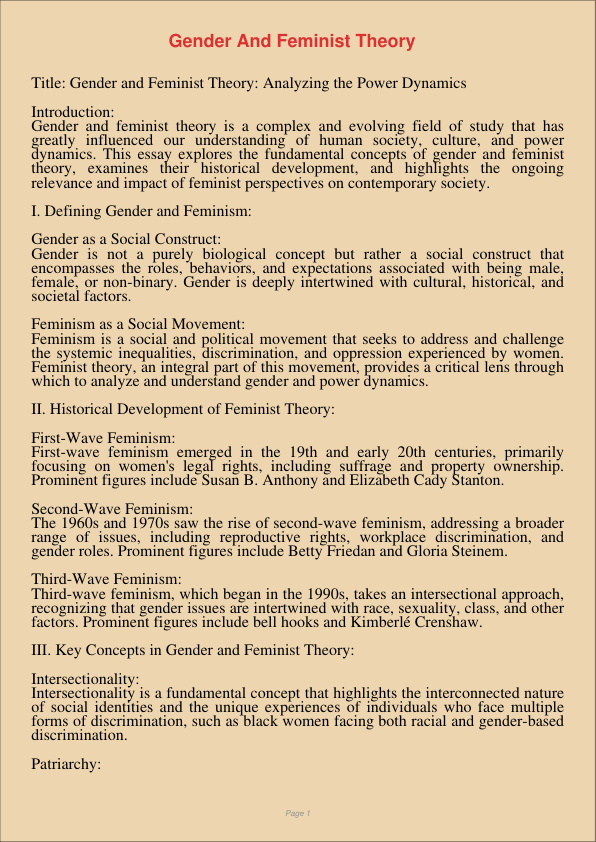Gender And Feminist Theory
Jan 8, 2024
feminist theory
gender
Geography
Philosophy
Title: Gender and Feminist Theory: Analyzing the Power Dynamics
Introduction: Gender and feminist theory is a complex and evolving field of study that has greatly influenced our understanding of human society, culture, and power dynamics. This essay explores the fundamental concepts of gender and feminist theory, examines their historical development, and highlights the ongoing relevance and impact of feminist perspectives on contemporary society.
I. Defining Gender and Feminism:
Gender as a Social Construct: Gender is not a purely biological concept but rather a social construct that encompasses the roles, behaviors, and expectations associated with being male, female, or non-binary. Gender is deeply intertwined with cultural, historical, and societal factors.
Feminism as a Social Movement: Feminism is a social and political movement that seeks to address and challenge the systemic inequalities, discrimination, and oppression experienced by women. Feminist theory, an integral part of this movement, provides a critical lens through which to analyze and understand gender and power dynamics.
II. Historical Development of Feminist Theory:
First-Wave Feminism: First-wave feminism emerged in the 19th and early 20th centuries, primarily focusing on women’s legal rights, including suffrage and property ownership. Prominent figures include Susan B. Anthony and Elizabeth Cady Stanton.
Second-Wave Feminism: The 1960s and 1970s saw the rise of second-wave feminism, addressing a broader range of issues, including reproductive rights, workplace discrimination, and gender roles. Prominent figures include Betty Friedan and Gloria Steinem.
Third-Wave Feminism: Third-wave feminism, which began in the 1990s, takes an intersectional approach, recognizing that gender issues are intertwined with race, sexuality, class, and other factors. Prominent figures include bell hooks and Kimberlé Crenshaw.
III. Key Concepts in Gender and Feminist Theory:
Intersectionality: Intersectionality is a fundamental concept that highlights the interconnected nature of social identities and the unique experiences of individuals who face multiple forms of discrimination, such as black women facing both racial and gender-based discrimination.
Patriarchy: Patriarchy is a central concept in feminist theory, referring to a system of power and control that privileges men while subordinating women. Feminist scholars argue that patriarchy permeates many aspects of society, including politics, economics, and culture.
Gender Performativity: Philosopher Judith Butler introduced the idea of gender performativity, which suggests that gender is not something inherent but rather a set of behaviors and expressions that individuals enact and perform.
IV. Contemporary Relevance:
#MeToo Movement: The #MeToo movement, which gained prominence in recent years, highlights the ongoing struggle for gender equality by shedding light on issues related to sexual harassment and assault. It demonstrates the continued importance of feminist perspectives in addressing gender-based discrimination.
Gender Pay Gap: Despite progress, the gender pay gap persists in many countries, illustrating the ongoing relevance of feminist theory in addressing economic disparities based on gender.
LGBTQ+ Rights: The LGBTQ+ rights movement intersects with feminism, as both movements advocate for equality and acceptance. Issues such as marriage equality and transgender rights are central to contemporary discussions about gender and sexuality.
Conclusion:
Gender and feminist theory provides invaluable tools for understanding the intricate dynamics of power, identity, and inequality. This essay has explored the development of feminist theory, its key concepts, and its contemporary relevance. In an ever-evolving society, the insights offered by gender and feminist theory remain vital in challenging and dismantling the structures of patriarchy and oppression, thereby contributing to a more equitable and just world for all.
